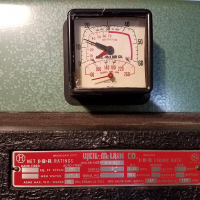Welcome! Here are the website rules, as well as some tips for using this forum.
Need to contact us? Visit https://heatinghelp.com/contact-us/.
Click here to Find a Contractor in your area.
Righty tighty lefty loosey or opposite...
Options
hutchinsron
Member Posts: 28
Hi all,
I have began disassembling some American Radiators that are too big for dollys. This first plug is it righty tighty/lefty loosey or are they reverse threads?
I have began disassembling some American Radiators that are too big for dollys. This first plug is it righty tighty/lefty loosey or are they reverse threads?

0
Comments
-
-
-
Why struggle with taking plugs and fittings out if you just want to disassemble the sections? That is just taking out the connecting rods and then wedging the sections apart--carefully. Cast iron radiators are nice things. Very good heaters. Be nice to them!0
-
The connecting rods might be hidden, and the connecting rod nuts might be behind the plugs. Take a look at the photos in his other posts. He tried to sell them. An item's value is only what someone is willing to pay minus transaction and shipping costs. Some really neat old things have negative value when you do the math.psb75 said:Why struggle with taking plugs and fittings out if you just want to disassemble the sections? That is just taking out the connecting rods and then wedging the sections
I DIY.0 -
Not on those Cortos. Right/left threaded nipples were used to join the sections. there are no rods. Look at any "Ideal Fitter" book after 1925 or so and you'll see what I mean.WMno57 said:
The connecting rods might be hidden, and the connecting rod nuts might be behind the plugs. Take a look at the photos in his other posts. He tried to sell them. An item's value is only what someone is willing to pay minus transaction and shipping costs. Some really neat old things have negative value when you do the math.psb75 said:Why struggle with taking plugs and fittings out if you just want to disassemble the sections? That is just taking out the connecting rods and then wedging the sections
All Steamed Up, Inc.
Towson, MD, USA
Steam, Vapor & Hot-Water Heating Specialists
Oil & Gas Burner Service
Consulting1 -
Yes, these radiators have no connecting rods (would have loved that), they are R/L threaded connectors. I am only taking apart the beasts that are 8-9' long that cannot be moved with muscle alone. Based on my success on the one radiator I cut with a sawzall the threaded inserts do move and can be broken down in this way with a spud wrench.0
-
I've taken threaded nipples between sections out to divide long (attractive) radiators into two. One side of the nipple and casting is right hand and the other side is left hand. They aren't always a pipe thread. Sometimes they are a similar thread without a taper. A right or left hand NPT nipple or fitting can be used on the "new" end with a lot of tape and sealant. To divide the radiator I break one of the sections with a hammer to expose the nipples. A radiator needs to be special to justify the amount of time and effort this work requires.1
Categories
- All Categories
- 85.2K THE MAIN WALL
- 3.1K A-C, Heat Pumps & Refrigeration
- 55 Biomass
- 424 Carbon Monoxide Awareness
- 73 Chimneys & Flues
- 1.9K Domestic Hot Water
- 5.2K Gas Heating
- 129 Geothermal
- 160 Indoor-Air Quality
- 3.3K Oil Heating
- 61 Pipe Deterioration
- 884 Plumbing
- 5.9K Radiant Heating
- 376 Solar
- 14.7K Strictly Steam
- 3.2K Thermostats and Controls
- 59 Water Quality
- 49 Industry Classes
- 89 Job Opportunities
- 28 Recall Announcements


